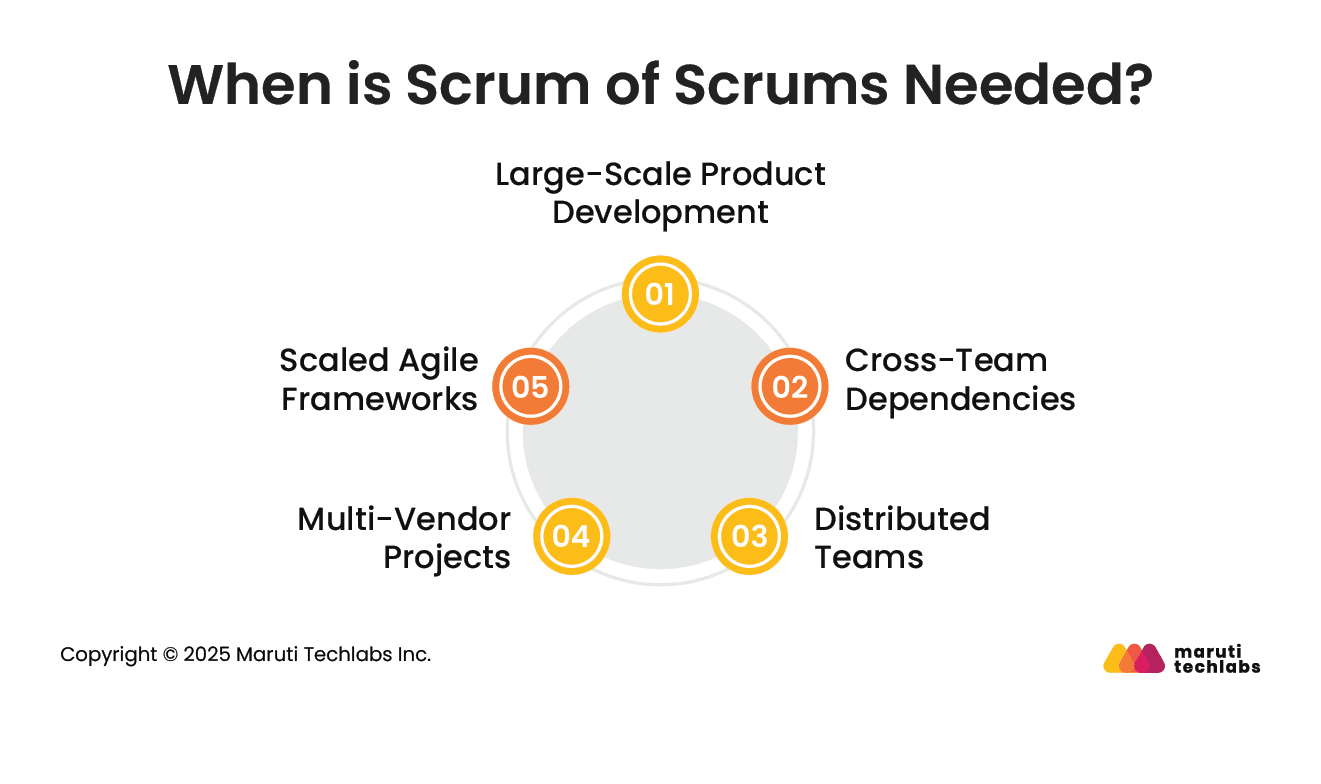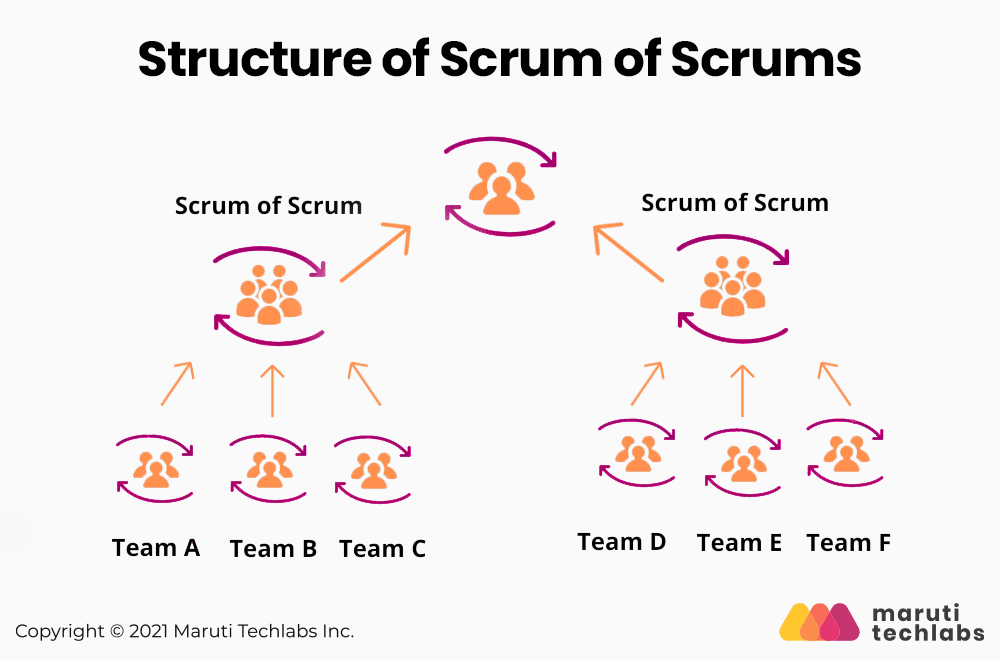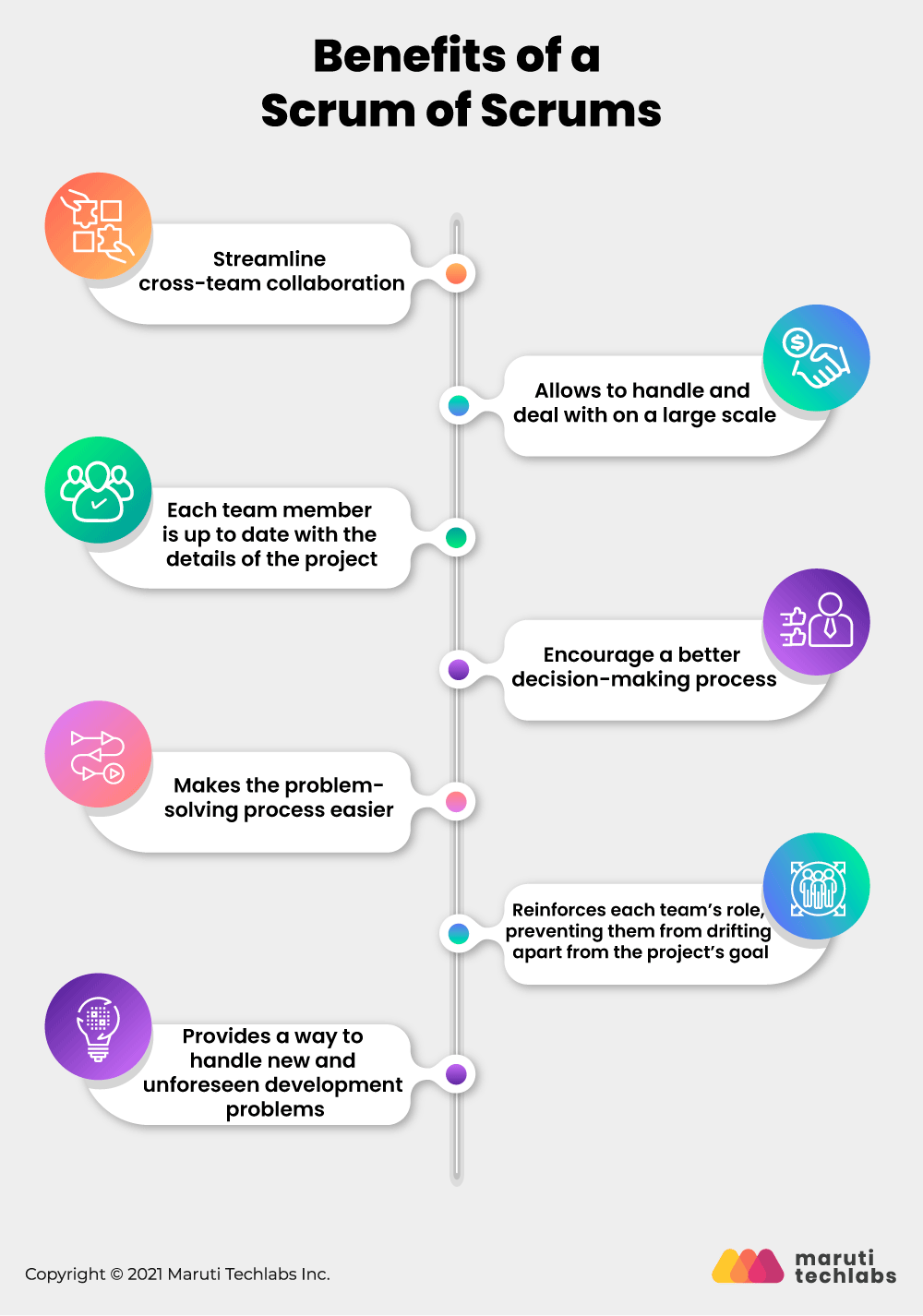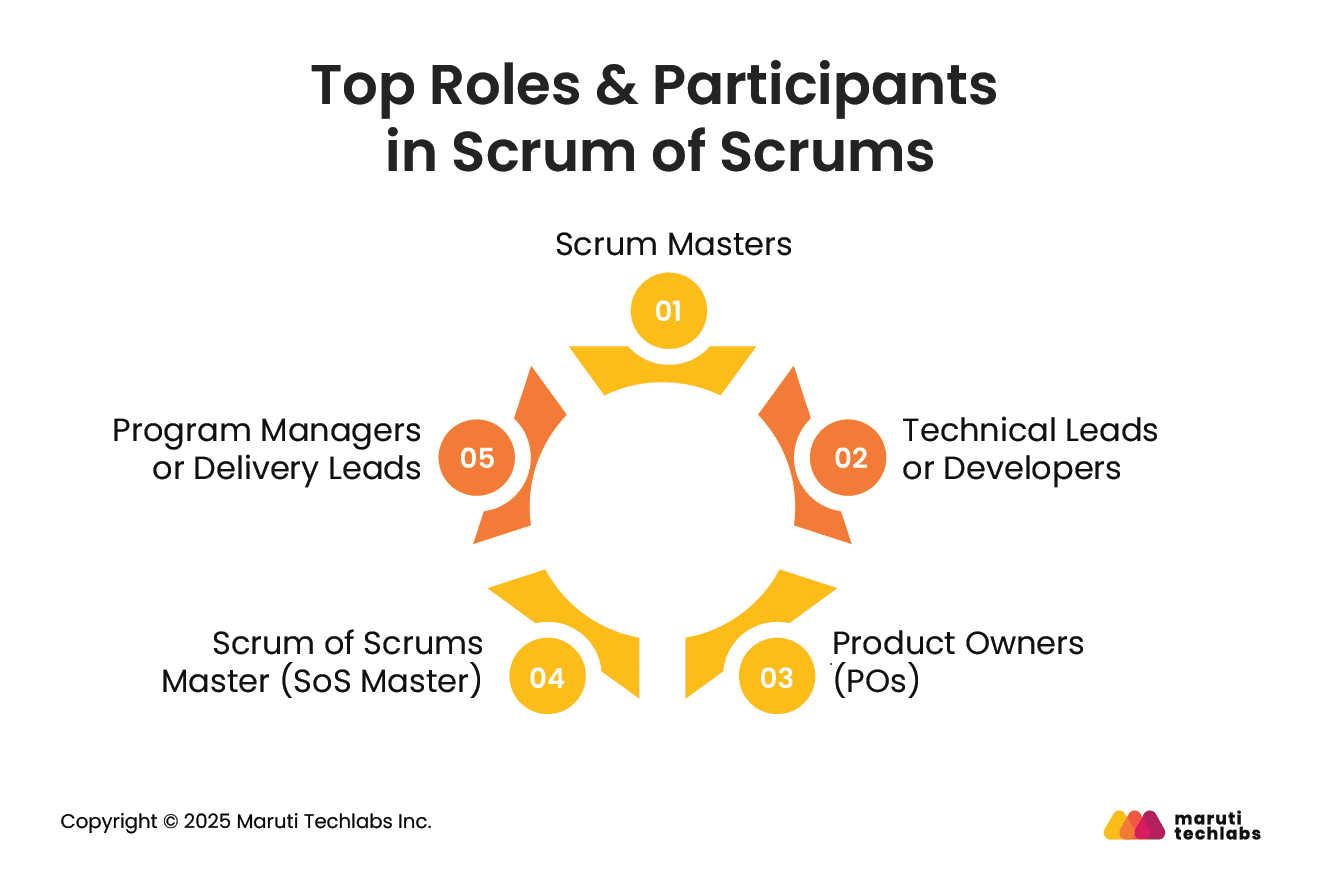

Scrum of Scrums: Purpose, Agenda & Framework Explained






The number of people on your team can significantly impact your business. When you’re starting your business initially, it’s easy to keep track of everything that needs to be done. But as the team grows, things can get out of hand.
Hey there! This blog is almost about 2600+ words long & not everyone likes to read that much.
We understand that.This is precisely why we made a podcast on the topic. Mitul Makadia, CEO & Founder of Maruti Techlabs, talks to Bikshita Bhattacharyya about his Agile implementation, strategy, and process during the nascent stages of the company.
As organizations embrace Agile at scale, coordinating multiple Scrum teams becomes a growing challenge. That’s where Scrum of Scrums comes in. A proven framework that extends Scrum’s core principles to large-scale projects.
By facilitating structured communication across teams, Scrum of Scrums enables alignment, removes cross-team blockers, and enhances delivery speed without sacrificing agility.
According to the 17th Annual State of Agile Report by Digital.ai, Scrum continues to be the most popular team-level methodology: 63% of Agile users are team Scrum.
Its benefits include improved transparency, faster decision-making, and smoother integration of work across dependencies.
In this blog, we’ll explore how to run an effective Scrum of Scrums, complete with meeting agendas, key roles and responsibilities, best practices, and customizable scaling templates.
Whether you're an Agile coach or delivery manager, this guide will help you coordinate complex initiatives with clarity and cohesion.
The Scrum of Scrums framework was first introduced by Jeff Sutherland and Ken Schwaber in 1996 while operating at the Lawrence Livermore National Laboratory. The original purpose of this framework was to coordinate the activities of eight business units with multiple product lines per business unit in a single development cycle.
Sutherland and Schwaber found that having separate scrum teams for each business unit impeded workflow within and across business units, so they experimented. They gathered all eight product teams into a single room. They had their work together by forming a meta-team or “Scrum of Scrums” to create an environment where independent teams could synchronize their efforts more efficiently.
Later, in 2001, Sutherland published this experience under the title “Agile Can Scale: Inventing and Reinventing SCRUM in Five Companies,” which mentioned Scrum of scrums for the first time.
“Scrum of Scrums (SoS) is a scaling mechanism used to coordinate multiple Scrum teams working on the same product or project. It functions as a cross-team synchronization meeting, enabling teams to align on progress, dependencies, and blockers while maintaining agility at scale.”
Scrum of Scrums is designed to be a lightweight solution for scaling agile methods. The main benefit of the Scrum of Scrums approach is to provide a way to enhance communication by connecting people from different Scrum teams who need to collaborate and coordinate with each other.
The essential Scrum of Scrums’ purpose is that multiple teams are working on a single product, and there needs to be a way for all of these teams to communicate with each other.
It’s particularly relevant for organizations with teams across geographies and time zones because it provides a means for teams to synchronize their work, communicate any issues or delays, and coordinate planning activities.
According to the definition of Jeff Sutherland, “Scrum of scrums as I have used it is responsible for delivering the working software of all teams to the Definition of Done at the end of the Sprint, or for releases during the sprint.”
A Scrum of Scrums (SoS) is a meeting between two sprints, where the development team discusses their inter-team dependencies. The scaled agile framework is run by the development team members, who are best positioned to discuss inter-team dependencies and find a solution.
Scrum of Scrums helps deploy and deliver complex products by adapting transparency and inspection at a large scale. It enables scrum teams to work towards common goals and complete the project by aligning.
Participants present at the Scrum of Scrums answer similar questions like daily Scrum. For instance:
There are various techniques by which you can implement the Scrum of Scrums. It could be a meeting within the team or with all teams. Therefore, scrum of scrum definition aims to get all teams in sync with each other so that any dependencies between teams have been identified and resolved.
Scrum of Scrums exists to bridge communication gaps between teams in large-scale Agile environments. Its primary goals are to ensure coordination across teams, integrate deliverables effectively, and identify or resolve inter-team impediments early.
By promoting transparency and collaboration, it helps maintain a steady delivery flow and supports the Agile principle of adaptability, even at scale.
A Scrum of Scrums meeting can be a valuable way to communicate with organizations with different goals. Here’s how:
Scrum of Scrums becomes essential when multiple Scrum teams are working toward a shared goal and need structured coordination to avoid misalignment, delays, or integration challenges.
Here are key scenarios where Scrum of Scrums is needed:

When a single product requires the efforts of several Scrum teams working in parallel, Scrum of Scrums ensures that progress remains synchronized and dependencies are managed proactively.
If teams rely on each other’s deliverables such as shared components, APIs, or services, SoS helps surface blockers early and fosters collaborative problem-solving.
In globally distributed environments, SoS provides a centralized communication rhythm, ensuring all teams stay aligned despite geographic or time zone differences.
When multiple vendors or departments contribute to a common initiative, Scrum of Scrums provides a neutral ground for aligning efforts and tracking integration points.
In organizations using structured scaling frameworks, Scrum of Scrums is a foundational ceremony for aligning teams at the program or train level.
In all cases, it fosters transparency, alignment, and faster issue resolution across teams.
Scrum of Scrums divides a large team into smaller scrum teams or subteams. Each subteam will have its daily standups, sprint planning sessions, and other events as part of a Scrum of Scrums meetings.
The basic idea is to give each subteam the autonomy to plan their work independently while still coordinating with the rest of the team—just as independent teams do in a traditional scrum. Here, the large number of people divided into smaller scrum teams can include up to 10 members in each team.
Each team chooses one developer to act as spokesperson, often known as “ambassador” for daily standups during their scaled Scrum. Another role is the Scrum of Scrums master, similar to the Scrum Master for Scrum methodology but at a higher level.

A Scrum of Scrums team is a cross-functional team that includes representatives from multiple Scrum teams. It follows the same practices and events as an individual Scrum team, and each member of the Scrum of Scrums team has the same role as a member of the corresponding Scrum team. However, to deploy the potentially integrated product at the end of every sprint, new additional roles are included here, not found in Scrum teams.
For instance, there is the quality assurance leader in every Scrum of Scrums team. The quality assurance leader is responsible for overseeing, testing, and maintaining the quality of the final product at the end of each sprint.
Another such role is Scrum of Scrums Master, who is responsible for focusing on the progress and product backlogs, facilitating prioritization, and continuously improving the effectiveness of Scrum of Scrums.
These roles take up the 15 minutes of scaled daily Scrum meet-ups to align and improve the impediments of the project. Here, each team’s product owner or ambassador discusses each team’s requirements, risks, and sprint goals with the other team. It also identifies the improvements of their team that other groups can leverage to achieve the final product.

Scrum of Scrums is indeed considered one of the agile best practices for more effective teams. It facilitates better collaboration, coordination, scalability, and flexibility, especially in larger and more complex projects. Here are some key points highlighting the benefits and principles of Scrum of Scrums:
Scrum of Scrums is the best way to scale agile to organizations with multiple teams. As for the Scrum of Scrums( SoS) meeting agenda, below are some of the SoS best practices to consider for getting the team composition right and conducting an effective meeting:
The success of a Scrum of Scrums (SoS) heavily depends on having the right participants who can speak to team progress, dependencies, and impediments.
Unlike regular stand-ups, SoS involves representatives from multiple teams, usually not the entire team to ensure concise and strategic communication.
Key roles include:
Masters often participate as team representatives, especially when coordination, risk mitigation, or obstacle removal is the primary focus. They bring visibility into team-level blockers and help escalate issues.
These are team members with a deep understanding of the product or technical dependencies. Their presence is crucial when architecture, integration, or delivery risks are involved.
While not always required in every SoS, POs may join when backlog alignment, prioritization conflicts, or cross-team feature dependencies need resolution.

This role facilitates the SoS meeting, ensures accountability, and removes escalated impediments. The SoS Master acts like a Chief Scrum Master or Release Train Engineer in scaled frameworks.
These stakeholders may observe or participate when broader delivery oversight or milestone tracking is necessary.
Ultimately, participation should be flexible, adapting to the project’s needs and maturity level.
The team itself should decide the frequency of this meeting. According to Ken Schwaber, the sessions should happen daily and last no longer than 15 minutes. However, a Scrum team may discover that it does not need to meet as often as initially planned.
It is more effective to schedule meetings less frequently yet for more extended periods. You can do it by holding two or three sessions a week instead of daily encounters. It allows team members to focus on any issues that may arise, rather than addressing them in the daily meeting, often revisiting prior problems and concerns.
When an issue is identified that requires attention and discussion, you must discuss it as soon as possible. When many people are involved in determining the issue, it is often a problem affecting the work of large groups of people. It deserves to be resolved as soon as possible. Therefore, while a scrum of scrums meeting may last only fifteen minutes, everyone should budget more time to discuss potential problems.
As organizations grow beyond 5–9 Scrum teams, a single Scrum of Scrums (SoS) may no longer suffice to coordinate work effectively.
In such cases, a Scrum-of-Scrums of Scrums (SoSoS), a higher-level synchronization layer is introduced.
This structure creates a hierarchical alignment model, where representatives from multiple SoS meetings participate in a higher-tier SoS to address broader integration challenges.
Use SoSoS when:
This tiered approach mirrors organizational structure without becoming bureaucratic. Each level retains the Agile spirit focusing on alignment, blockers, and integration while maintaining clear escalation paths.
For large-scale frameworks like SAFe, LeSS Huge, or Nexus+, this layered structure ensures continuous flow, faster decision-making, and delivery confidence across the enterprise.
Scrum of Scrums is a unique approach to lead your organization towards agility. It’s a method of holding meetings and tracking progress while maintaining productivity. SoS ensures that meetings are more efficient, streamlined, and effective. It can help your organization become more agile—as it allows for faster development cycles and improved communication amongst the various teams involved in any given project.
We hope you enjoyed learning about Scrum of Scrums and how you can implement it to help your team deliver products in a timely and cohesive manner.
Also read : A Comprehensive Guide to Scrum Sprint Planning.
With over 12 years of experience in addressing business challenges with digital transformation, we have what it takes to help companies bridge the gap between digital vision and reality.
A perfect software product demands an equally excellent execution methodology. At Maruti Techlabs, follow Agile, Lean, and DevOps best practices to create a superior prototype that brings your users’ ideas to fruition through collaboration and rapid execution. Our Agile experts can also help you identify the possible impediments that can be destructive for your business in achieving sprint goals.
Get in touch with us for a free consultation and learn how our product development services can transform your business vision into market-ready software solutions.


